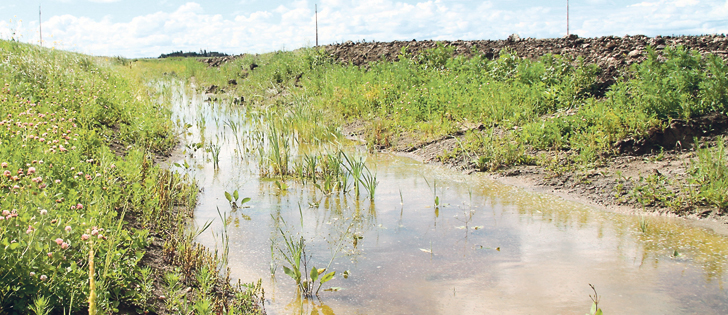An on-field drainage system allows early spring runoff and improves root and soil structure, says expert
Manitoba’s soil and water protection heretics say farmers and society can achieve everything they want, but they can only do it with a holistic approach.
That means soil conservation and water protection can occur on the same field and make the farmer money, but only if they are managed as a whole.
“You really can create a win-win-win situation, with improved agronomics, improved economics and improved environmental performance, if it’s done in an integrated fashion,” said David Lobb, a University of Manitoba soil scientist, in a presentation to the Manitoba Farm Writers and Broadcasters Association.
Read Also

Container dispute embroils Port of Vancouver
GCT wants to expand its existing container terminal at the Port of Vancouver, but it is running into opposition from the port itself.
Lobb and fellow soil scientist Don Flaten have been challenging many assumptions about soil conservation and water protection in recent years, revealing research showing surprising results of commonly accepted practices.
For instance, conservation tillage tends to cause more nutrient outflow from farms rather than less. Also, well-protected and highly vegetated riparian areas tend to be causes of nutrients fouling downstream water, rather than a way of reducing it.
Lobb said conservation tillage tends to cause downstream eutrophication by leaving crop residue on fields, and because most water flowing off farmland occurs during the spring melt, the melt water carries more with it from a frozen minimum-tilled field than a field that was tilled and frozen.
As well, grassed drains, ditches and stream banks bring up nutrients from the soil and put them into plants, which then die and release their nutrients right at the surface for runoff to move.
But Lobb said re-engineering farm fields could better remove spring melt water, produce better crops and improve downstream water flow and water quality.
“Conservation tillage we’ve shown to be bad for water quality,” said Lobb. “It’s good for (reducing) soil loss, but bad for water quality.”
Instead of draining farms in the Red River Valley by guiding the water through surface drains to the edge of fields and then dumping it into ditches, the surface drains and tile drainage could be reconfigured to guide the water toward a field-edge pond. That would stop nutrient-loaded water gushing downstream and provide a rich source of irrigation water.
“It ends up being no bigger than their farmyard,” said Lobb about the size of the pond required to hold the runoff from a quarter section.
Getting the water off the field quickly in spring will help farmers grow bigger and better crops, the irrigation water can be used for boosting crop growth in dry patches, and keeping the water within the farm rather than being dumped into the municipal drainage system keeps the farmer in charge of the situation.
“It’s the most effective thing you can do on the farm,” said Lobb.
Within such a system, on-field drainage will also improve even before hitting surface drains or tile drainage because improving plant growth from a better managed system will produce better roots and better soil structure.
“Managing at the plant level is absolutely key,” said Lobb.
Trying to force farmers to hold on to water won’t likely work, and he doesn’t like the sound of a coercive approach. Instead, an integrated system like his model offers farmers better crops, fewer risks and more freedom to farm.
Farmers have worked hard to protect their soils with conservation tillage. If they connect a water protection element, they will manage to have everything: better soil, less criticism for nutrient emissions, higher value crops and freedom from water politics and regulation, he said.
Top 10 farming practices to save Lake Winnipeg
- Use low disturbance field equipment to improve soil structure.
- Use retention ponds to retain and reuse or detain and release surface water before it leaves the farm.
- Use better surface drainage management to control and collect excess soil moisture.
- Use tile drainage to control and collect excess soil moisture.
- Manage vegetation within riparian areas and roadside ditches as a crop that is harvested, and, thereby, remove nutrients that would otherwise flow downstream.
- Manage vegetation within in-field drains as a crop that is harvested, and, thereby, remove nutrients that would otherwise flow downstream.
- Use small dams to retain and reuse or detain and release surface water before it leaves the farm.
- Use wetlands to retain surface water before it leaves the farm.
- Form the land surface of in-field surface drains to slow surface runoff and thereby increase infiltration and sedimentation.
- Form the land surface within riparian areas to slow surface runoff and thereby increase infiltration and sedimentation.
















